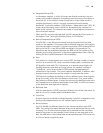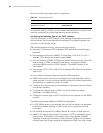84 CHAPTER 5: IP ROUTING PROTOCOL OPERATION
Configuring OSPF You must first enable OSPF then specify the interface and area ID before
configuring other functions. However, the configuration of functions that are
related to the interface does not depend on whether OSPF is enabled. However, if
OSPF is disabled, the OSPF-related interface parameters become invalid.
OSPF configuration includes tasks that are described in the following sections:
■ Enabling OSPF and Entering OSPF View
■ Entering OSPF Area View
■ Specifying the Interface
■ Configuring Router ID
■ Configuring the Network Type on the OSPF Interface
■ Configuring the Cost for Sending Packets on an Interface
■ Setting the Interface Priority for DR Election
■ Setting the Peer
■ Setting the Interval of Hello Packet Transmission
■ Setting a Dead Timer for the Neighboring Routers
■ Configuring an Interval Required for Sending LSU Packets
■ Setting an Interval for LSA Retransmission Between Neighboring Routers
■ Setting a Shortest Path First (SPF) Calculation Interval for OSPF
■ Configuring the OSPF STUB Area
■ Configuring NSSA of OSPF
■ Configuring the Route Summarization of OSPF Area
■ Configuring OSPF Virtual Link
■ Configuring Summarization of Imported Routes by OSPF
■ Configuring the OSPF Area to Support Packet Authentication
■ Configuring OSPF Packet Authentication
■ Configuring OSPF to Import the Routes of Other Protocols
■ Configuring Parameters for OSPF to Import External Routes
■ Configuring OSPF to Import the Default Route
■ Setting OSPF Route Preference
■ Configuring OSPF Route Filtering
■ Configuring Filling the MTU Field When an Interface Transmits DD Packets
■ Disabling the Interface to Send OSPF Packets
■ Configuring OSPF and Network Management System (NMS)
■ Resetting the OSPF Process
■ Displaying and Debugging OSPF


















